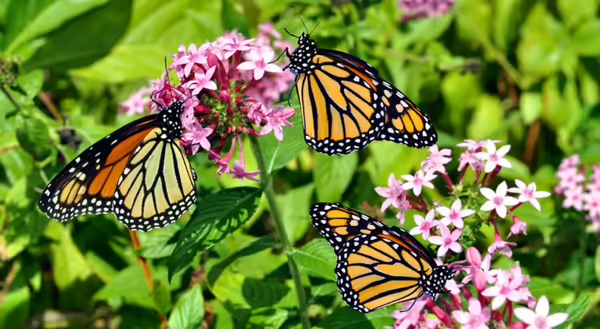
Monarch’s proposed addition to Threatened Species list
This past December, the U.S. Fish and Wildlife Service (USFWS) proposed for the monarch butterfly to be added to the threatened species list, which would place the monarch under the protection of the Endangered Species Act (ESA) via Docket (FWS-R3-ES-2024-0137). If added, the USFWS, with the Environmental Protection Agency (EPA), will be responsible for adequately adjusting the ESA Section 4(d) rule, which provides tailored regulations for the species on the endangered and threatened species list. Currently, these administrations are accepting public comment on their proposal, giving stakeholders, such as pesticide applicators and conservationists, the opportunity to voice their perspectives about issues facing monarch butterflies to influence future regulatory adjustments to the Section 4(d) rule.
The monarch butterfly, one of the most iconic insect species and symbols of ecological health, has faced a dramatic population decline over recent decades. The eastern migratory monarch butterfly population, which populates the Midwest, has seen a reduction of 80% since 1980, while the western migratory population has experienced a 95% decrease during that same time frame. This population decline has been attributed to habitat loss, pesticide use, and adverse environmental conditions. The docket posted by USFWS states this concerning the monarch’s population decline:
The primary drivers affecting the health of the two North American migratory populations are loss and degradation of breeding, migratory, and overwintering habitat (from past conversion of grasslands and shrublands to agriculture and widespread use of herbicides; logging/thinning at overwintering sites in Mexico; urban development, senescence, and incompatible management of overwintering sites in California; and drought); exposure to insecticides; and effects of climate change.
The USFWS identifies habitat loss, particularly the conversion of grasslands and shrubland to agriculture, as a key to changing populations, as it results in the removal of natural nectar resources and decreased prevalence of milkweed, the sole host for monarch caterpillars. Herbicides, such as glyphosate, are specifically named as a further cause for the loss of these plants, as “a majority of the past milkweed loss has occurred in agricultural lands.” In addition, insecticides such as neonicotinoids can threaten adult survival by contaminating pollen or nectar of plants that grow adjacent to crops with a seed treatment. These agricultural practices have been deemed essential by the USFWS, but the concern for monarchs remains.
Issues with agriculture
One of the key issues with the decline of the monarch population identified by the USFWS is the previously converted grass and shrubland to agricultural land. The docket states that converting natural habitats to agricultural lands was a major driver of initial monarch population declines through habitat loss supporting nectar and milkweed resources. In contrast, the document clarifies that lands that have already been converted from monarch habitats are not likely to contribute to further population decline. Therefore, agricultural lands are encouraged to manage vegetation when monarchs are not present because correctly managed habitats will be better for monarchs’ long term, even if milkweed and nectar resources are being removed in the short term. This mentality by the USFWS has resulted in the docket's encouragement for all mechanical maintenance of agricultural and range lands when monarchs are not present, even when the maintenance results in the destruction of the monarch’s resources. USFWS still aims to “achieve a significant increase in the availability of milkweed and nectar plants in monarch breeding and migratory areas.” Still, the service believes this can be done through public support and programs that focus on planting milkweed and adult food sources on land that isn’t directly used for agriculture.
Potential effects on pesticide usage
The USFWS has said it aims to “avoid and minimize impacts to monarchs and their habitat from insecticides and herbicides.” This goal described in the document could result in some restrictions on pesticide use, particularly in agriculture. The USFWS docket does not explicitly propose specific pesticide restrictions that would apply outside of California but mentions glyphosate and various insecticide classes, including neonicotinoids, pyrethroids, and organophosphates, as having potentially harmful effects on monarch populations. The USFWS has specifically requested public comments concerning pesticides that could impact monarch populations, if “an exception for the use of pesticides and, if so, what measures are reasonable, feasible, and adequate to reduce or offset pesticide exposure to monarchs from agricultural and non-agricultural.” The docket further includes a request for information on pesticides' indirect or direct effects, application methods, uses, and potential mitigation measures. Only after the public contributes comments will the USFWS and EPA move forward to revise the section 4(d) rule of the Endangered Species Act. Any revision would likely focus on pesticide use in monarch breeding areas and migratory routes.
If you would like to comment or view current comments on this docket, you can do that here. You can also view other topics on which the USFWS is requesting information under the “Information Requested” section of the original document. The commenting period on this docket is open till March 12, 2025.
Photo credit: Monarch butterflies Latin name Danaus plexippus - AdobeStock
ABOUT THE AUTHOR: John Schepis provides subject matter expertise and training in pesticide safety with an emphasis on entomology.